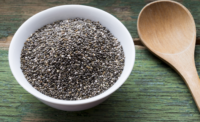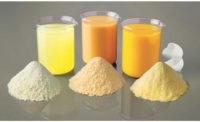Keeping up with changing consumer desires is a constant activity. The shifting perceptions of snack and bakery categories are no different.
Looking at mega trends is usually a good place to start—and health-and-wellness is a big one, as are ingredient simplification and label transparency. According to the IRI report, “How America Eats: 2016 State of the Snack Food Industry,” 52 percent of consumers want additional health benefits beyond nutrition (e.g., antioxidants) in their snack, 57 percent of consumers want a snack that contains vitamins and minerals and 49 percent want a snack that delivers a serving of fruit and vegetables.
But according to a July 2015 Centers for Disease Control and Prevention study, “Adults Meeting Fruit and Vegetable Intake Recommendations,” 76 percent of the U.S. population do not meet the recommended guideline for fruit consumption.
To deliver on these consumer desires and nutritional needs, the addition of fruit in various forms to snack products and baked goods is a natural solution.
Fruitful benefits
Fruit brings a multitude of benefits. “Fruit has natural sugar, but also brings great attributes like fibers, antioxidants and other beneficial qualities,” says Dax Schaefer, executive chef, Asenzya, Oak Creek, WI. “For example, stone fruits such as cherries are delicious but have a slightly exotic feel and provide health benefits in the form of antioxidants.”
Fruits and fruit flavors also help formulators add flavor variety and visual interest to products. “Consumers, especially millennials, love to see what they are buying,” says Schaefer. “This has led to packaging that is clear or nearly clear. Transparent packaging has helped drive the demand for particulates. Pieces of fruits and nuts give visual appeal and, ultimately, that leads to product trial.”
Selecting the right ingredient format is vital to product appearance, though. “Many dark specialty fruits—strawberries, blackberries and raspberries, for example—contain a significant amount of moisture in their frozen or shelf-stable state,” says Becky Westby, director of sales, Oregon Fruit Products, Salem, OR. “This can be very challenging for baked goods. We find that we are more successful adding these fruits in a dehydrated, flaked or low-moisture form for snacks and baked goods. ”
Fields of opportunity
Unique fruits are also starting to get the nod. According to the most-recent “What’s Hot” survey from the National Restaurant Association, heirloom apples and exotic fruits are top produce trends.
One exotic fruit that has been garnering attention is coffee fruit, formerly a byproduct of coffee product. Processors are converting the fruit to a powder/flour for use in baked goods and other products. Some have ranked it among superfruits in terms of its nutritional value, with high iron, fiber, antioxidant and potassium content. And since coffee fruit has long been considered a nuisance byproduct, it lends a degree of sustainability and environmental sensibility to foods. (For a feature-length look at coffee fruit and flour, visit www.snackandbakery.com.)
While mango is not totally unfamiliar, it shows signs of growing more popular in snack and bakery items. “When you look at the mango’s global popularity, great taste and health benefits, you can see why it is a natural selection for the American consumer that is looking for new ethnic and functional products,” says Schaefer.
“Tropical fruits like passion fruit and mango can complement many ethnic foods,” says Westby. “These fruits have the ability to meld with spicy flavors, creating dimension and complex flavors for bakery items.”
Mango ingredients also bring technical benefits. “Mango purées, in particular, can be used as a replacement for fat,” says Westby. “Fruit prep and compotes can effectively reduce moisture in bakery items and replace liquids, with the added benefit of delivering texture and authentic flavor. Fruits also can be an excellent alternative to added sugar, because it provides a natural sweetness. Plus fruits offer antioxidants, vitamins, minerals and fiber that other sweeteners don’t have.”
Paul Altaffer, chief innovation officer, RFI Ingredients, Blauvelt, NY, is fond of acerola, a fruit grown abundantly in Brazil. “Acerola is interesting because it has high vitamin C content when the fruit is still green,” he says. “With other fruits, as the fruit ripens, the sugar content and the vitamin C content increase. Since this does not happen with the acerola, it has a much higher vitamin C to sugar content ratio. So you can have a good source of vitamin C without as much sugar. The fruit is mild in flavor, a bit tart and tangy.”
For snack or bar applications, Altaffer suggests the goldenberry. “This is in the same family as some Asian fruits and the tomatillo,” he says. “It is tangy, sweet and sour. It is consumed a lot in Peru, and people eat it as a dried fruit, like a raisin. Goldenberries are a source of vitamin A and linoleic acid.”
Sowing seeds
Like coffee fruit, other agricultural “byproducts” are finding original uses—and perhaps lending environmental benefits to a product’s image. “Someone who is forward-thinking might want to consider the cashew apple fruit or the juice of cocoa pod,” says Altaffer. “In the case of the cashew, the cashew nut grows in a pod under the apple. The pod is separated from the apple and then the nut is separated from the pod. The fruit is usually thrown out or given to cattle to eat. For the cocoa pod, the juice is a throw-away product since the seeds are valuable. Cocoa juice is inexpensive and has a lot of sweetness.”
Altaffer also sees fermentation as a way to bring something new via fruit. “Fermentation is an old technology that is being rediscovered,” he says. “There’s interest in this technology, because fermentation breaks down carbs and sugars. Polyphenols become more bioavailable, antioxidant values may go up and the food may be easier to digest. Through fermentation, you can reduce sugar and carbs but maintain nutrient content.” He notes that fermented fruit powders are available, including fermented apple, blueberry, cranberry, raspberry and strawberry.
“Everyone wants the next cool thing,” says Altaffer. “Developing them requires more planning, so you have to adjust your expectations.” One thing we know to expect: Consumer desire will continue to challenge formulators to keep pace with their ever-changing expectations.






